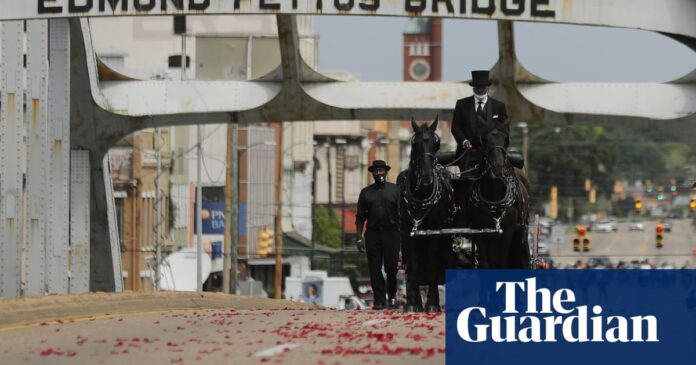John Lewis crossed the Edmund Pettus Bridge in Selma, Alabama, for the last time on Sunday, as remembrances continued for the civil rights leader and congressman.
A native of Pike county, Alabama, Lewis died on 17 July aged 80, several months after announcing advanced pancreatic cancer.
The bridge became a landmark in the fight for racial justice when Lewis and other marchers were beaten there 55 years ago on Bloody Sunday, a key event in the fight for voting rights for African Americans.
On Sunday state troopers and police officers stood along barricaded sidewalks as Lewis’s body was carried across.
Frank and Ellen Hill had driven more than four hours from Monroe, Louisiana, to watch the procession. Frank Hill, 60, said he remembered watching footage of Lewis and other civil rights marchers being beaten.
“I had to come back and see John Lewis cross the bridge for the last time,” Hill told the Associated Press. “It’s funny to see the state troopers here to honor and respect him rather than beat the crap out of him.”
As the wagon approached the bridge, members of the crowd shouted “Thank you, John Lewis!” and “Good trouble!”, the phrase Lewis used to describe his tangles with white authorities during the civil rights movement.
Some crowd members sang the gospel song Woke Up This Morning With My Mind Stayed on Jesus. Later, some onlookers sang the civil rights anthem We Shall Overcome and other gospel tunes.
The wagon rolled over a carpet of rose petals, pausing atop the bridge over the Alabama River in the summer heat so family members could walk behind it. On the south side of the bridge, where Lewis was beaten in 1965, family members placed red roses that the carriage rolled over, marking the spot where Lewis spilled his blood and suffered a head injury.
As a military honor guard lifted Lewis’ casket from the horse-drawn wagon into an automobile hearse, Alabama state troopers, including some African American ones, saluted.
Calls to rename the bridge for Lewis are increasing.
On Sunday Kerry Kennedy, a human rights campaigner and daughter of the former US attorney general, senator and presidential candidate Robert Kennedy, with whom Lewis forged a strong friendship, told the Guardian: “I think it would be great because Edmund Pettus was a terrible white supremacist and there should not be anything named after him.”
Pettus was a lawyer and Confederate general who became a US senator and leader in the Ku Klux Klan.
“It would be a symbol to Selma and to our country and to the world that we recognise the violence of the past,” Kennedy said, “and we are going to atone for it and we are on our way to becoming a more perfect union – one where all people are respected and where every person is treated with dignity.”
After the ceremonies in Selma, Lewis’ body was taken to the Alabama capitol to lie in repose, retracing the route marchers took in the days after Bloody Sunday to demand justice from Alabama governor George Wallace.
Bertha Surles and Edna Goldsmith stood along the highway between Selma and Montgomery. Both carried signs, reading “Thank you”.
“He fought for rights up unto his death,” said Surles, 70.
She was in high school on Bloody Sunday and remembered watching footage of Lewis being beaten.
“They didn’t give up and something good came from it. Still need some improvement, but something good came from it.”
“John was willing to sacrifice life so we can have the freedom to vote,” said Goldsmith, who was wearing a Black Lives Matter shirt. “We want to see him off with a bang.”
A series of events began on Saturday in Lewis’ hometown of Troy, Alabama. He will lie in state at the US Capitol in Washington next week before a private funeral on Thursday at the historic Ebenezer Baptist church in Atlanta, which the Rev Martin Luther King Jr once led.






